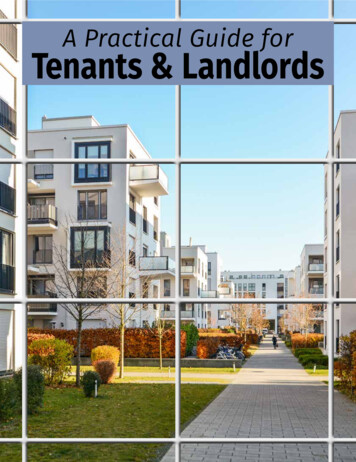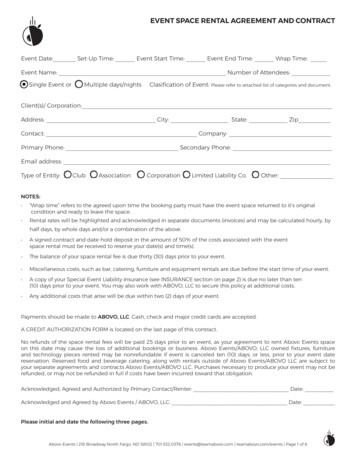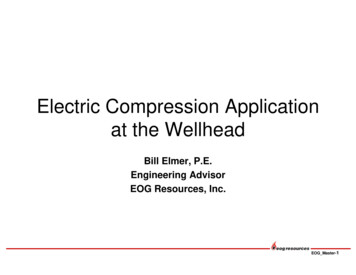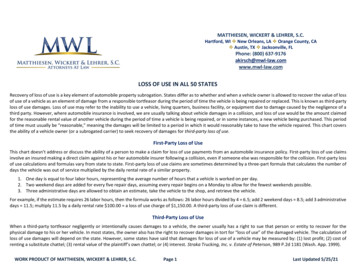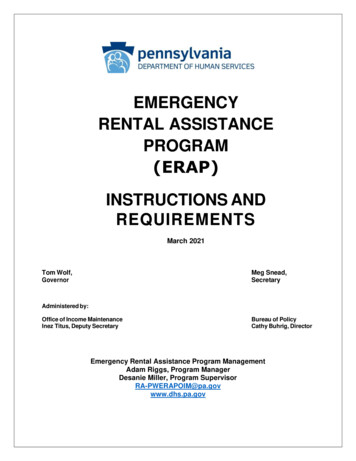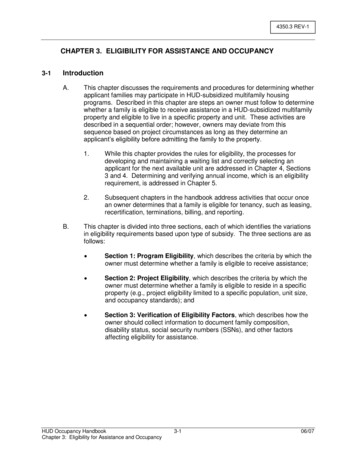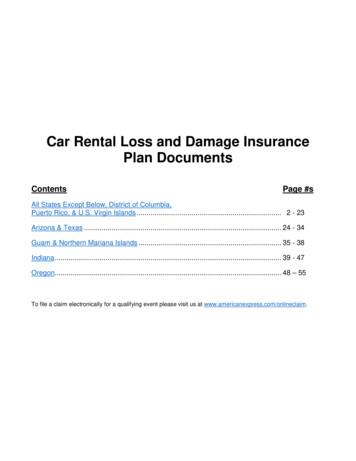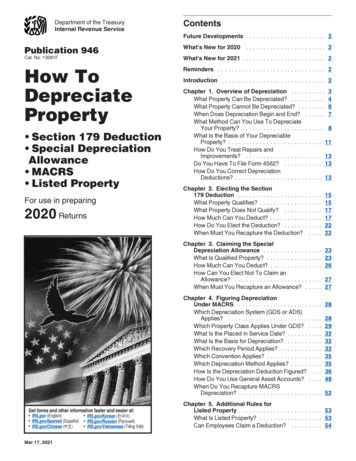
Transcription
ADMINISTRATIVE PLANfor theRENTAL ASSISTANCE PAYMENTS PROGRAM“RAP”July 1, 2019OUR MISSION .A Connecticut where affordable housing, in strong,vibrant and inclusive communities, is accessible to individuals andfamilies across the state and homelessness is a thing of the past.
TABLE OF CONTENTSChapter 1STATEMENT OF POLICIES AND OBJECTIVES. 1-1A.DEPARTMENT OVERVIEW . 1-1B.LOCAL OBJECTIVES . 1-2C.PURPOSE OF THE PLAN . 1-3D.TERMINOLOGY . 1-3E.FAIR HOUSING POLICY . 1-6F.REASONABLE ACCOMMODATIONS POLICY . 1-7G.TRANSLATION OF DOCUMENTS. 1-11H.MANAGEMENT ASSESSMENT OBJECTIVES . 1-11I.RECORDS FOR MONITORING HA PERFORMANCE . 1-11J.PRIVACY RIGHTS . 1-14K.FAMILY OUTREACH . 1-14L.OWNER OUTREACH . 1-15Chapter 2ELIGIBILITY FOR ADMISSION . 2-1A.ELIGIBILITY FACTORS . 2-1B.INCOME LIMITATIONS . 2-2C.MANDATORY SOCIAL SECURITY NUMBERS . 2-2D.CITIZEN/ELIGIBLE IMMIGRATION STATUS . 2-3E.TENANT SCREENING AND SUITABILITY OF FAMILY . 2-3F.CHANGES IN ELIGIBILITY PRIOR TO EFFECTIVE DATE OF CONTRACT . 2-4G.INELIGIBLE FAMILIES . 2-4Chapter 3APPLYING FOR ADMISSION . 3-1TOC - i
TABLE OF CONTENTSA.PROHIBITION AGAINST DENIAL OF ASSISTANCE TO VICTIMS OF DOMESTICVIOLENCE, DATING VIOLENCE AND STALKING [§ 24 CFR Part 5, Subpart L] . 3-1B.OVERVIEW OF THE APPLICATION-TAKING PROCESS . 3-5C.OPENING AND CLOSING OF APPLICATION-TAKING . 3-6D.INITIAL APPLICATION PROCEDURES . 3-7E.APPLICANT STATUS WHILE ON WAITING LIST . 3-8F.TIME OF SELECTION . 3-8G.COMPLETION OF A FULL APPLICATION . 3-9H.VERIFICATION . 3-9I.FINAL DETERMINATION AND NOTIFICATION OF ELIGIBILITY . 3-9Chapter 4MAINTAINING THE WAITING LIST . 4-1A.WAITING LIST . 4-1B.REMOVAL (OR PURGING) FROM THE WAITING LIST . 4-2Chapter 5SUBSIDY STANDARDS [§ 24 CFR 982.54(d)(9)] . 5-3A.DETERMINING CERTIFICATE SIZE . 5-3B.EXCEPTIONS TO SUBSIDY STANDARDS . 5-5C.UNIT SIZE SELECTED . 5-7Chapter 6FACTORS RELATED TO TOTAL TENANT PAYMENT AND FAMILY SHAREDETERMINATION. 6-1A.INCOME AND ALLOWANCES . 6-1B.DISALLOWANCE OF EARNED INCOME FROM RENT DETERMINATIONS FORPERSONS WITH DISABILITIES . 6-5C.DEFINITION OF TEMPORARILY OR PERMANENTLY ABSENT . 6-9D.AVERAGING INCOME . 6-15TOC - ii
TABLE OF CONTENTSE.MINIMUM INCOME . 6-15F.INCOME OF PERSON PERMANENTLY CONFINED TO NURSING HOME . 6-16G.REGULAR CONTRIBUTIONS AND GIFTS . 6-16H.ALIMONY AND CHILD SUPPORT . 6-16I.LUMP-SUM RECEIPTS . 6-17J.CONTRIBUTIONS TO RETIREMENT FUNDS - ASSETS . 6-19K.ASSETS DISPOSED OF FOR LESS THAN FAIR MARKET VALUE . 6-19L.CHILD CARE EXPENSES . 6-19M.MEDICAL EXPENSES . 6-20N.PRO-RATION OF ASSISTANCE FOR MIXED FAMILIES . 6-20O.INCOME CHANGES RESULTING FROM WELFARE PROGRAM REDUCTIONS . 6-21P.UTILITY ALLOWANCE. 6-22Chapter 7VERIFICATION PROCEDURES . 7-1A.METHODS OF VERIFICATION AND TIME ALLOWED . 7-1B.RELEASE OF INFORMATION . 7-3C.ITEMS TO BE VERIFIED . 7-4D.VERIFICATION OF INCOME. 7-4E.INCOME FROM ASSETS . 7-9F.VERIFICATION OF ASSETS. 7-10G.VERIFICATION OF ALLOWABLE DEDUCTIONS FROM INCOME . 7-12H.VERIFICATION OF NON-FINANCIAL FACTORS . 7-14Chapter 8VOUCHER ISSUANCE AND BRIEFINGS . 8-1A.ISSUANCE OF CERTIFICATES . 8-1TOC - iii
TABLE OF CONTENTSB.BRIEFING TYPES AND REQUIRED ATTENDANCE . 8-2C.ENCOURAGING PARTICIPATION IN AREAS WITHOUT LOW-INCOME ORMINORITY CONCENTRATION . 8-5D.ASSISTANCE TO FAMILIES WHO CLAIM DISCRIMINATION . 8-5E.SECURITY DEPOSIT REQUIREMENTS . 8-6F.TERM OF CERTIFICATE . 8-6G.CERTIFICATE ISSUANCE DETERMINATION FOR SPLIT HOUSEHOLDS. 8-8H.REMAINING MEMBER OF TENANT FAMILY – CERTIFICATE RETENTION . 8-9Chapter 9REQUEST FOR TENANCY APPROVAL AND CONTRACT EXECUTION . 9-1A.REQUEST FOR TENANCY APPROVAL . 9-1B.ELIGIBLE TYPES OF HOUSING . 9-2C.LEASE REVIEW . 9-3D.SEPARATE AGREEMENTS . 9-4E.INITIAL INSPECTIONS . 9-4F.RENT LIMITATIONS. 9-5G.DISAPPROVAL OF PROPOSED RENT . 9-5H.INFORMATION TO OWNERS . 9-6I.CHANGE IN TENANT CONTRIBUTION PRIOR TO RAP EFFECTIVE DATE . 9-7J.CONTRACT EXECUTION PROCESS . 9-7K.PROOF OF OWNERSHIP. 9-7L.CHANGE IN OWNERSHIP . 9-8Chapter 10HOUSING QUALITY STANDARDS AND INSPECTIONS . 10-1A.GUIDELINES AND TYPES OF INSPECTIONS . 10-1B.INITIAL HQS INSPECTION . 10-2TOC - iv
TABLE OF CONTENTSC.ANNUAL HQS INSPECTIONS . 10-3D.SPECIAL/COMPLAINT INSPECTIONS . 10-4E.QUALITY CONTROL INSPECTIONS . 10-4F.ACCEPTABILITY CRITERIA AND EXCEPTIONS TO HQS . 10-5G.EMERGENCY REPAIR ITEMS . 10-6H.CONSEQUENCES IF OWNER IS RESPONSIBLE (NON-EMERGENCY ITEMS) . 10-7I.DETERMINATION OF RESPONSIBILITY . 10-9J.CONSEQUENCES IF FAMILY IS RESPONSIBLE . 10-9Chapter 11OWNER RENTS AND RENT REASONABLENESS . 11-1A.OWNER PAYMENTS. 11-1B.MAKING PAYMENTS TO OWNERS . 11-1C.RENT REASONABLENESS DETERMINATIONS . 11-2Chapter 12RE-EXAMINATIONS . 12-1A.ANNUAL ACTIVITIES . 12-1B.ANNUAL RE-EXAMINATION . 12-1C.REPORTING INTERIM CHANGES . 12-5D.NOTIFICATION OF RESULTS OF RE-EXAMINATIONS . 12-7E.TIMELY REPORTING OF CHANGES IN INCOME (AND ASSETS) . 12-7F.INCOME CHANGES RESULTING FROM WELFARE PROGRAMREQUIREMENTS . 12-9G.REPORTING OF CHANGES IN FAMILY COMPOSITION . 12-9Chapter 13A.MOVES WITH CONTINUED ASSISTANCE . 13-1ALLOWABLE MOVES . 13-1TOC - v
TABLE OF CONTENTSB.RESTRICTIONS ON MOVES . 13-1C.PROCEDURE FOR MOVES . 13-2Chapter 14CONTRACT TERMINATIONS . 14-1A.CONTRACT TERMINATION . 14-1B.TERMINATION BY THE FAMILY: MOVES . 14-1C.TERMINATION OF TENANCY BY THE OWNER: EVICTIONS . 14-2D.TERMINATION OF THE CONTRACT BY THE HA . 14-3Chapter 15DENIAL OR TERMINATION OF ASSISTANCE . 15-1A.GROUNDS FOR DENIAL OR TERMINATION OF ASSISTANCE . 15-1B.FAMILY OBLIGATIONS (Regulation Section 17b-812-12). 15-3C.NOTICE OF TERMINATION OF ASSISTANCE . 15-11D.MISREPRESENTATION IN COLLUSION WITH OWNER . 15-11E.MISSED APPOINTMENTS AND DEADLINES . 15-11Chapter 16OWNER DISAPPROVAL AND RESTRICTION . 16-1A.DISAPPROVAL OF OWNER . 16-1B.OWNER RESTRICTIONS AND PENALTIES . 16-2C.CHANGE IN OWNERSHIP . 16-2Chapter 17OWNER OR FAMILY DEBTS TO THE PHA . 17-1A.REPAYMENT AGREEMENT FOR FAMILIES . 17-1B.DEBTS OWED DUE TO FAMILY ERROR . 17-2C.DEBTS DUE TO PROGRAM FRAUD AND ABUSE . 17-2D.GUIDELINES FOR REPAYMENT AGREEMENTS. 17-2TOC - vi
TABLE OF CONTENTSE.Chapter 18OWNER DEBTS TO THE HA . 17-3COMPLAINTS AND ADMINISTRATIVE FAIR HEARINGS . 18-1A.COMPLAINTS TO THE HA . 18-1B.APPLICANT/PARTICIPANT RIGHT TO AN ADMINISTRATIVE FAIR HEARING. 18-2Chapter 19SPECIAL HOUSING TYPES . 19-1A.MANUFACTURED HOUSING . 19-1B.SPECIAL HOUSING TYPES AS REASONABLE ACCOMMODATION . 19-4TOC - vii
Chapter 1STATEMENT OF POLICIES AND OBJECTIVESINTRODUCTIONThe State of Connecticut Department of Housing (“DOH”) Rental Assistance Program(RAP), created by legislation in 1985 through Substitute Senate Bill No. 883, is intended tosupplement the Federal Section 8 Housing Program (now known as the Housing ChoiceVoucher Program) by providing an opportunity for low-income families to live in decent, safeand sanitary housing (see Sections 17b-812-1 through 17b-812-14 of the Regulations ofConnecticut State Agencies). While modeled on the Housing Choice Voucher Program, RAPdiffers from that program in some respects. The program requirements of RAP are describedin and implemented through this administrative plan which is designed to explain andelaborate upon the regulations governing RAP.On July 1, 2013, the DOH assumed responsibility for the administration of RAP from theConnecticut Department of Social Services.RAP administration shall be conducted inaccordance with federal, state and local Fair Housing laws and regulations. The DOH and itssubcontractors shall be in compliance with the State Code of Ethics as set forth in Conn.General Statutes Sections 1-79 through 1-101 inclusive.JURISDICTIONJurisdiction covers the entire state of Connecticut.A. DEPARTMENT OVERVIEWDOH is a statewide public agency that works in concert with municipal leaders, publicagencies, community groups, local housing authorities, and other housing developers in theplanning and development of affordable homeownership and rental housing units, thepreservation of existing multi-family housing developments, community revitalization andfinancial and other support for our most vulnerable residents through our funding andtechnical support programs. As the State's lead agency for all matters relating to housing,DOH provides leadership for all aspects of policy and planning relating to the development,1-1
redevelopment, preservation, maintenance and improvement of housing serving very low,low, and moderate-income individuals and families. DOH is also responsible for overseeingcompliance with applicable statutes, regulations and financial assistance agreements forfunded activities through long-term program compliance monitoring.DOH strengthens and revitalizes communities by promoting affordable housingopportunities. DOH seeks to eliminate homelessness and to catalyze the creation andpreservation of quality, affordable housing to meet the needs of all individuals and familiesstatewide to ensure that Connecticut continues to be a great place to live and work.The executive management of the department is vested in a Commissioner of Housing anda Deputy Commissioner. The Department of Economic and Community Development,which provides shared services, including but not limited to Human Resources,Communication and Information Technology, supports DOH administratively.Bystatute, a statewide Housing Advisory Council provides guidance and assistance to theCommissioner. The department has approximately 35 full-time employees and administersmore than one-hundred and thirty million dollars in state general fund and state bond fundallocations, in addition to another fifty million dollars in direct federal grant funds.Within the department, the Office of Individual and Family Programs is authorized toadminister the Rental Assistance Program. In addition to the RAP, the group maintainsoversight of the Section 8 Housing Choice Voucher Program and the Section 8 ModerateRehabilitation Program.B. LOCAL OBJECTIVESRAP is designed to achieve these major objectives:1. To provide decent, safe and sanitary housing for very low income families whilemaintaining their rent payments at an affordable level.2. To annually ensure that all RAP-subsidized units meet housing quality standards(“HQS”) and that families pay fair and reasonable rents.1-2
3. To promote fair housing and the opportunity for very low income families of all ethnicbackgrounds to experience freedom of housing choice.4. To promote a housing program which maintains quality service and integrity whileproviding an incentive to private property owners to rent to very low income families.In addition, DOH has the following goals for the program:1. To assist the local economy by increasing the occupancy rate and the amount of moneyflowing into the community.2. To encourage self-sufficiency of participating families.3. To create positive public awareness and expand the level of family, owner, andcommunity support in accomplishing DOH’s housing mission.4. To attain and maintain a high level of standards and professionalism in the day-to-daymanagement of all RAP components.5. To administer an efficient, high-performing program through continuousimprovement of the support systems used in RAP and to demonstrate thecommitment of DOH to its employees and contractors and to their development.C. PURPOSE OF THE PLANThe purpose of this Administrative Plan is to establish policies for administering RAP in amanner consistent with state regulations. The plan covers both admission to, andcontinued participation in, the RAP.DOH is responsible for complying with statutes and regulations governing RAP and foramending regulations pertaining to the program when necessary.D. TERMINOLOGYThe State of Connecticut Department of Housing and/or its contract administrator isreferred to as the “Housing Authority” or “HA” throughout this plan.1-3
“Family” includes but is not limited to: A family with or without children (the temporary absence of a child from the home dueto placement in foster care shall not be considered in determining family composition andfamily size) An elderly family A near-elderly family A displaced family A household The remaining member of a household, and A single person who is not an elderly or displaced person or a person with disabilitiesor the remaining member of a household.“Head of Household” is the person who assumes legal and financial responsibility for thehousehold and is listed on the application as the head."Tenant" is used to refer to participants in terms of their relation to landlords."Landlord" and "owner" are used interchangeably.“Person with Disabilities” is a person who has a disability as defined in 42 U.S.C. 423 or adevelopmental disability as defined in 42 U.S.C. 6001. It also includes a person who isdetermined, under HUD regulations, to have a physical or mental impairment that isexpected to be of long-continued and indefinite duration, substantially impedes the abilityto live independently and is of such a nature that the ability to live independently could beimproved by more suitable housing conditions. For purposes of reasonable accommodationand program accessibility for persons with disabilities, means an “individual withhandicaps” as defined in § 24 CFR 8.3. This definition does not exclude persons who haveAIDS or conditions arising from AIDS, but does not include a person whose disability isbased solely on drug or alcohol dependence (for low-income housing eligibility purposes).1-4
"HQS" means Housing Quality Standards required by HUD regulations and modified inaccordance with Chapter 10 of this document."Failure to Provide" refers to all requirements set forth in the first family obligation notedin Chapter 15, "Denial or Termination of Assistance."“Spouse” is the husband or wife of the head of the household.“Co-Head” is an individual in the household who is equally responsible for the lease withthe Head of Household. (A family never has a co-head and a spouse and a co-head is never adependent).“Live-In Aide” is a person who resides with an elderly person or disabled person and who isdetermined to be essential to the care and well-being of the person, is not obligated for thesupport of the person and would not be living in the unit except to provide necessarysupportive services.“Split Households” are when a family on the waiting list splits into two otherwise eligiblefamilies due to divorce or legal separation, the new families both claim the same placementon the waiting list, and there is no court determination. The HA will make the decisiontaking into consideration the following factors:1. Which family member applied as head of household.2. Which family unit retains the children or any disabled or elderly members.3. Restrictions that were in place at the time the family applied.4. Role of domestic violence or criminal activity in the split.5. Recommendations of social service agencies or qualified professionals such as thoseemployed by children's protective services.1-5
Documentation of these factors is the responsibility of the applicant families. If either orboth of the families do not provide the documentation, they may be denied placement onthe waiting list for failure to supply information requested by the HA.“Multiple Families in the Same Household” are when families apply which consist of twofamilies living together (such as a mother and father, and a daughter with her own husbandor children). If they apply as a family unit, they will be treated as a family unit.“Joint Custody of Children” Children who are subject to a joint custody agreement but livewith one parent at least 51% of the time will be considered members of the household. 51%of the time is defined as 183 or more days of the year, which do not have to runconsecutively.When both parents are on the waiting list and both are trying to claim the child, the parentwhose address is listed in the school records will be allowed to claim the school-age child asa dependent.E. FAIR HOUSING POLICYIt is the policy of the Housing Authority to comply fully with all federal, state, and localnondiscrimination laws and with the rules and regulations governing Fair Housing andEqual Opportunity in housing and employment.The HA shall not deny any family or individual the opportunity to apply for or receiveassistance under the Rental Assistance Program on the basis of race, color, sex, religion,creed, national or ethnic origin, age, family, marital status, handicap, disability or sexualorientation, ancestry, gender identity or expression, familial status, or lawful source ofincome. The HA will make every effort to provide training and materials to its staff toenable them to inform owners and tenants of Connecticut General Statute 46a-64c1-6
(concerning discrimination based on sources of income) and 46a-7 (discrimination based onphysical or mental disability).To further its commitment to full compliance with applicable civil rights laws, the HA willprovide federal, state and local information to RAP certificate holders regardingdiscrimination and any recourse available to them if they believe they are victims ofdiscrimination. Such information will be made available during the family briefing sessionheld to facilitate receipt of the RAP certificate, and all applicable Fair Housinginformation and discrimination complaint forms will be made a part of the RAP certificateholder's briefing packet.No individual with a disability shall be denied the benefits of or be excluded fromparticipation in RAP or otherwise be subjected to discrimination because the HA's facilitiesare inaccessible to or unusable by persons with disabilities.Posters and housing information will be displayed in locations throughout the HA's officesincluding in places that are easily readable from a wheelchair.The HA’s offices will be accessible to persons with disabilities. Accessibility for the hearingimpaired is provided by the TTD/TDY telephone service provider.F. REASONABLE ACCOMMODATIONS POLICYThis policy is applicable to all situations described in this Administrative Plan when afamily initiates contact with the HA (including when a family applies to participate inRAP), when the HA initiates contact with a family, and when the HA schedules orreschedules appointments of any kind. A reasonable accommodations package is providedto all participants.1-7
It is the policy of this HA to be service-oriented in the administration of DOH housingprograms and to exercise and demonstrate a high level of professionalism while providinghousing services to families.Persons with DisabilitiesThe policies and practices of the HA are designed to provide assurances that all personswith disabilities will be provided reasonable accommodation so that they may fully accessand utilize RAP and related services. The availability of specific accommodations will bemade known by including notices on HA forms and letters to all families, and all requestsfor accommodation will be verified so that the HA can properly accommodate the needpresented by the disability.A person requesting a reasonable accommodation must meet the definition of a person witha disability, as “disability” is defined in the Americans with Disabilities Act (“ADA”):1. With respect to an individual, the term "disability" means: A physical or mental impairment that substantially limits one or more of the majorlife activities of an individual A record of such impairment, or Being regarded as having such an impairment.2. Those "regarded as having such an impairment" may include those with conditions suchas obesity or cosmetic disfigurement, and individuals perceived to be at high risk ofincurring a work-related injury.3. Individuals with contagious diseases who do not pose a direct threat to others arecovered by the Federal Americans with Disabilities Act. Persons with AIDS and thosewho test positive for the HIV virus are considered to have a disability.The term “physical or mental impairment” includes alcoholism and drug addiction, otherthan addiction caused by current, illegal use of a controlled substance. A person who hassuccessfully completed a supervised drug rehabilitation program or has otherwise beensuccessfully rehabilitated and is no longer engaging in the illegal use of drugs, or is1-8
participating in a supervised rehabilitation program and is no longer engaging in the illegaluse of drugs, is covered under the ADA. Current drug users are not covered.A person requesting a reasonable accommodation should explain what type ofaccommodation the person is requesting and, if the need for the accommodation is notreadily apparent or not known to the HA, explain the relationship between the requestedaccommodation and the disability. A person with a disability that is not readily apparentmust provide the HA with reliable information that verifies that the person meets thedefinition of disabled, describes the needed accommodation, and shows the relationshipbetween the person’s disability and the need for the requested accommodation. The HAwill provide forms to assist a person making a reasonable accommodation request to verifysuch information, although the person
RAP is designed to achieve these major objectives: 1. To provide decent, safe and sanitary housing for very low income families while maintaining their rent payments at an affordable level. 2. To annually ensure that all RAP-subsidized units meet housing quality standards (“H

